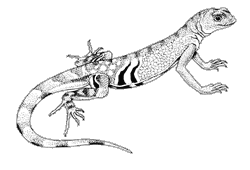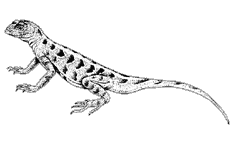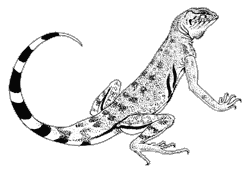"Sand" Lizards
Fringe-toed Lizard (Uma spp.)
Greater earless Lizard (Cophosaurus texanus)
Lesser earless Lizard (Holbrookia maculata)
Zebra-tailed Lizard (Callisaurus draconoides)
Order: Squamata
Family: Iguanidae (iguanid lizards)
Spanish names: lagartija de las dunas (fringe-toed lizard), lagartija (greater earless lizard), lagartija (lesser earless lizard), perrita (zebra-tailed lizard)
Distinguishing Features
This is a group of small- to medium-sized lizards with wedge-shaped heads and countersunk jaws, smooth granular scales, and dark crescents or bars on the sides of their bellies. Color is usually sandy tan to salmon with irregular spots, blotches, or bars of darker tan to brown. Uma spp. tend to have extensive networks of light spots with dark centers. Aside from the fringe-toed lizard, the species are easily confused. Their defining characteristics are outlined below.

Greater earless lizard
Range
Fringe-toed lizards are restricted to southeastern California, southwestern Arizona, northeastern Baja California, and northwestern Sonora, Mexico. The greater earless lizard is found in southeastern Arizona; southern New Mexico; central, west, and south Texas into Mexico at elevations up to 5600 feet (1700 m). The lesser earless lizard occurs in 5 central to western states, including eastern Arizona, south to Guanajuato, Mexico at elevations ranging from sea level to 7000 feet (2130 m). The zebra-tailed lizard ranges from Nevada and southeastern California through the western half of Arizona south throughout much of Baja California, Sonora and Sinaloa, Mexico at elevations ranging from sea level to 5000 feet (1520 m).
Habitat

Lesser earless lizard
Fringe-toed lizards occur only in low desert areas having fine, loose, sandy substrate. The greater earless lizard seems to prefer rocky bajadas and canyons in upland desert areas with mesquite, ocotillo, palo verde, and occasional creosote bush, in sandy or gravelly soils; it often rests on large rocks. The lesser earless lizard is more of a habitat generalist, occurring in desert grassland, Sonoran desertscrub, pinyon-juniper woodlands, thornscrub, and tropical deciduous forest; it is usually found in open areas with loamy soils. The zebra-tailed lizard is most commonly encountered in canyon bottoms, washes, desert pavement, and hardpan, where plant growth is minimal and there are wide or long stretches of open sandy soil.
Life History
All of these lizards are insectivorous, though some may also eat small lizards. They breed from spring to summer laying between 1 to 15 eggs, with the fringe-toed lizard usually laying fewer eggs than the other species. Eggs take 60 to 75 days to hatch.
Females of several lizard species exhibit color changes during breeding season. The “sand” lizards, for instance, develop bright orange or red areas on the different parts of the body. In some species this indicates readiness for breeding, while in others it is a signal to males that the female has already mated and is gravid (pregnant).

Zebra-tailed lizard
Comments
The fringe-toed lizard with its projecting toe scales, countersunk lower jaw, overlapping eye scales, and nasal valves is ideally suited to its sand dune habitat. Often it will dive into the sand to escape predators or extreme heat.
The zebra-tailed lizard has the peculiar habit of wagging its curled tail, which may serve to visually distract predators by drawing attention away from the lizard’s body and head. If a predator seizes the tail it easily detaches, a process known as autotomy. The tail has built-in fracture planes in the vertebrae to help it readily break off. The lizard grows back a cartilaginous replacement, which is shorter and has a different appearance than the original. Many species of lizards have this ability.
| Species | Ear Openings | Belly Marks | Tail Marks |
|---|---|---|---|
| fringe-toed | present | 1 large blotch | bars present |
| greater earless | absent | 2 crescents behind midbody | bars present (underside) |
| lesser earless | absent | 2 crescents midbody | bars absent |
| zebra-tailed | present | 2 crescents at or in front of midbody | bars present (tail often banded) |










